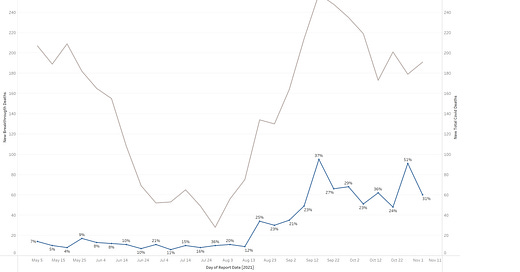A recent Bad Cat post discusses the financial incentives involved in COVID reporting between the vaccinated and unvaccinated. In the US, there are certainly incentives in play to find as many COVID + among the unvaccinated as possible (hospitals get more funding, funeral expenses covered, etc.). Meanwhile, for the vaccinated, it’s a more complicated story. Given the overwhelming public pressure to promote the vaccines, it’s not clear that the healthcare industry is as eager to find COVID+ vaccinated individuals.
Hypothetical scenarios:
Unvaccinated person needs to be hospitalized. They may or may not be experiencing COVID like symptoms. Either through direct policy of the hospital, or based on economic incentives, the hospital tests all unvaccinated people. Therefore, the data for unvaccinated patients would reflect both patients hospitalized for COVID as well as those with COVID (incidental infection).
Vaccinated person needs to be hospitalized. If that person is not experiencing COVID like symptoms, they may or may not be tested. While there may economic incentives to do so, there is also pressure to promote the vaccines and keeping the number of vaccinated hospitalizations low would also be an incentive not to test. Therefore, among the vaccinates, the expectation would be that all (or most) COVID+ folks with symptoms would be captured in the data, while only a portion of the asymptomatic COVID+ patients would be recorded that way.
Hypothesis:
Because of the above, COVID hospitalizations may not be being counted in the same way between the vaccinated and unvaccinated. Now, consider deaths. Suppose the above patients die:
Unvaccinated: Presuming both symptomatic and asymptomatic patients have already been tested, a death with be counted as a COVID death, whether with or from
Vaccinated: Symptomatic folks should have already been tested and will be counted as a COVID death. Asymptomatic folks may not have previously been tested, however now there is an additional incentive to test. Namely, the funeral benefits to the deceased family provides a powerful incentive to label the death COVID & the hospital may now catch these addition dies with cases.
Testing this hypothesis:
Data on breakthroughs in the US is extremely spotty. There is no national set of data the author is aware of. Some states, however, publish some data on this. Illinois publishes weekly breakthrough deaths and hospitalizations. Illinois also publishes cases and deaths. For all IL hospitalizations, data collected from HHS is used.
Below are plots of breakthrough deaths vs. all COVID deaths and breakthrough hospitalizations vs. all COVID hospitalizations for the weeks reported.
Interesting. While obviously not dispositive, the above charts are consistent with the stated hypothesis. Namely, the % of hospitalizations of breakthrough cases is significantly less than the % of deaths. This would be consistent with a situation where all COVID+ unvaccinated hospitalizations are recorded, while only a fraction of the vaccinated ones are.
Another way to look at this:
This shows the % of the hospitalized (breakthrough and total) that die with a COVID+ test. Taken at face value, this would say that if you are hospitalized with a COVID+ test, you are way more likely to die if vaccinated than if not (rather than the given hypothesis that is different testing policies driving an undercount of COVID+ vaccinated patients).
A confounder is that vaccinated and unvaccinated populations are different, with the vaccinated being older and thus more likely to serious disease and death based on age. For this to be a major factor, it would need to be that many more younger, unvaccinated people are being hospitalized and surviving. Breakdowns of hospitalizations by both vaccination status and age is not available as far as the author knows, but it seems unlikely these numbers would be large enough (young people just aren’t hospitalized that much in general) to fully explain the numbers above.
As always, additional thoughts and possible explanations are welcome. Also, pointers to other data sources to test this hypothesis is appreciated.







Good thought, thanks. Could you label the curves in the plots? Not easy to sort out which is which...